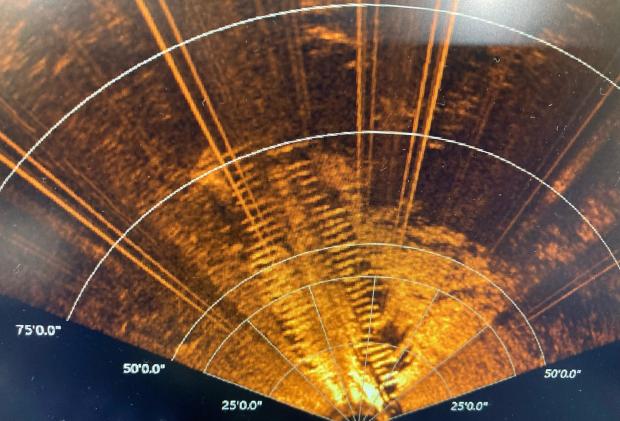A man and daughter fishing on Lake Michigan thought their sonar detected an octopus. It turned out it was likely an 1871 shipwreck.
Wisconsin archaeologists are crediting a man and his daughter with discovering the remains of what could be a ship that ran aground during the deadly Peshtigo Fire more than 150 years ago.
Tim Wollak and his 6-year-old daughter, Henley, of Peshtigo, were fishing on Lake Michigan in the bay of Green Bay near Green Island in August when their sonar picked up something Henley thought was an octopus, WLUK-TV reported Wednesday.
Wollak posted photos of the sonar images on Facebook, which eventually drew the attention of the Wisconsin Historical Society. The society posted a note Monday on Facebook saying an underwater remote vehicle surveyed the site on Dec. 4 and confirmed the object was the wreck of a three-masted sailing ship submerged in 8 to 10 feet of water.
Archaeologists believe the ship may be the 122-foot-long George L. Newman.
"On the evening of October 8, 1871, the barkentine was sailing through the thick smoke from the Great Peshtigo Fire – the deadliest fire in U.S. history – with a cargo of lumber from Little Suamico when it grounded on the southeast point of Green Island," the society wrote on Facebook.
The keeper of the island's lighthouse rescued the crew, according to the historical society, but the ship was abandoned and was eventually covered with sand and forgotten.
The historical society plans to survey the wreck again in the spring of 2024 and may push to list the site on the National Register of Historic Places.
"I don't know how we top it," Wollak told WLUK. "I told her (Henley) I'm pretty sure there's no one else in her school that has ever found a shipwreck that nobody had recorded before ... I guess we'll just have to fish more and see if we can find more shipwrecks."
The National Weather Service ranks the Peshtigo Fire as the most devastating forest fire in U.S. history, claiming more than 1,200 lives.
According to survivor accounts, railroad workers clearing land for tracks started a brush fire on Oct. 8, 1871, that grew into an inferno that scorched between 1.2 million and 1.5 million acres. The fire skipped east over the waters of Green Bay and set fire to parts of Door and Kewaunee counties.
The city of Peshtigo was consumed in an hour, according to the National Weather Service's website. Sixteen other towns burned as well.
Thousands of shipwrecks in the Great Lakes
News of the shipwreck comes about three months after a schooner that sank in Lake Michigan in 1881 was discovered with the crew's possessions in its final resting spot miles from Wisconsin's coastline. Historians called the finding of the 156-year-old Trinidad a "remarkable discovery."
Experts estimate more than 6,000 ships have gone down in the Great Lakes since the late 1600s.
In July, researchers searching for World War I-era minesweepers that mysteriously vanished in Lake Superior more than a century ago instead found a long-missing ship that sank to the bottom of the lake in 1879.
In April, researchers found the wreckage of two ships that disappeared in Lake Superior in 1914. In March, a ship carrying a load of coal when it sank in a storm in 1891 was discovered in the lake.
And in February, a 144-foot shipwreck that searchers called a "Bad Luck Barquentine" was found in Lake Superior more than 150 years after it sank.




